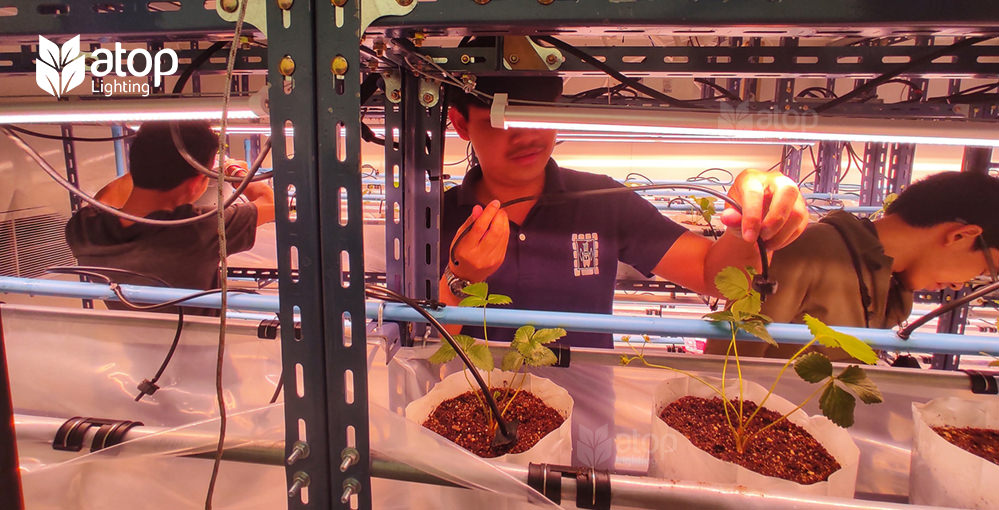Effects of UVA, Blue Light on Vine Crop and Other Plants
 Author: Agnes Feng Email: [email protected] Wechat/Whatsapp/Skype: +86 13128738533
Author: Agnes Feng Email: [email protected] Wechat/Whatsapp/Skype: +86 13128738533
Light is the most important environmental factor influencing plant growth and development. Light not only supplies energy for plant growth through photosynthesis, but is also an important regulator of plant growth and development.
The light in nature comes from the sun, and the solar spectrum is roughly divided into three parts:
- Photosynthetically active radiation 400-700nm wavelength (blue-violet light wavelength 400-500nm, green light wavelength 500-575nm, yellow-orange light wavelength 575-620nm, red light wavelength 620-700nm).
- Far-red light and infrared light>700nm ( Far-red light 700-780nm, infrared light 780nm-1000μm)
- Ultraviolet light <400nm (uv-a315-400nm, uv-b280-315nm, uv-c100-280nm). Among them, mid-ultraviolet UV-B and far-ultraviolet UV-C are mostly absorbed by the ozone layer above the earth, and the ultraviolet light reaching the ground is mainly near-ultraviolet UV-A.
1.1 Phytochrome
Phytochromes are covalently combined with a chromophore and apoprotein, including two types of far-red light absorbing (Pfr) and red light absorbing (Pr), mainly absorbing red light at 600-700nm and 700- The far-red light of 760nm regulates the physiological activities of plants through the reversible effect of far-red light and red light. In plants, phytochromes are mainly involved in the regulation of seed germination, seedling formation, establishment of photosynthetic systems, shade avoidance, flowering time, and circadian rhythm responses. In addition, it also plays a role in regulating the stress resistance physiology of plants.
1.2 Cryptochrome
Cryptochrome is a blue light receptor that mainly absorbs blue light at 320-500nm and near-ultraviolet UV-A, and the absorption peaks are roughly located at 375nm, 420nm, 450nm and 480nm. Cryptochromes play a major role in controlling plant flowering. In addition, it is involved in the regulation of plant tropism, stomatal opening, cell cycle, guard cell development, root development, abiotic stress, apical dominance, fruit and ovule development, programmed Cell death, seed dormancy, pathogen response, and magnetic field induction are all examples of biological processes.
1.3 Photophores
Luciferin is a blue light receptor discovered after phytochrome and cryptochrome, which can be phosphorylated after binding to flavin mononucleotide. It can regulate plant phototaxis, chloroplast movement, stomatal opening, leaf extension and inhibit hypocotyl elongation of etiolated seedlings.
2.1 Blu-ray
Blue light can significantly shorten the internode spacing of vegetables, promote the lateral extension of vegetables and reduce the leaf area. At the same time, blue light can also promote the accumulation of secondary metabolites in plants. In addition, it was found that blue light can alleviate the inhibition of red light on the activity of photosynthetic system and photosynthetic electron transfer ability of cucumber leaves, so blue light is an important factor affecting the activity of photosynthetic system and photosynthetic electron transfer ability. There are marked species differences in the need for blue light in plants. It was found that 470nm in different wavelengths of blue light had obvious effects on the content of anthocyanins and total phenols in strawberry after harvesting.
2.2 Ultraviolet light
Ultraviolet light is generally more of a killing effect on organisms, reducing plant leaf area, inhibiting hypocotyl elongation, reducing photosynthesis and productivity, and making plants more susceptible to infection. However, proper supplementation of UV light can promote the synthesis of anthocyanins and flavonoids, and by adding a small amount of UV-B to the postharvest cabbage to promote the synthesis of its polyphenols; postharvest UV-c treatment can slow down the fruiting of red peppers. The process of gum dissolution, mass loss and softening can significantly reduce the spoilage speed of red peppers and prolong the shelf life, and can promote the accumulation of phenolic substances on the surface of red peppers. In addition, ultraviolet light and blue light also affect the elongation and asymmetric growth of plant cells, thereby affecting the directional growth of plants. UV-B radiation resulted in a dwarf plant phenotype, small, thick leaves, short petioles, increased axillary branching, and changes in root/shoot ratio.
Blue light and red-blue mixed light had inhibitory effects on callus budding, among which blue light had the strongest inhibitory effect, with a budding rate of only 3%. The tissue culture seedlings of C. chinensis treated with a single red or blue LED had poor growth, while a certain ratio of red and blue LED composite light was beneficial to promote the growth of plants. The dry and fresh weight of strawberry sugar-free tissue culture seedlings under blue light was the smallest. The optimal ratio of red and blue LEDs for the growth of tissue culture seedlings is inconsistent with the research conclusions of different plants. Tissue culture seedlings grow best under the conditions of 70% red light + 30% blue light for Japanese double butterfly and strawberry. Red light favours stem elongation and dry matter accumulation in vegetable seedlings, while blue light favours protein accumulation and promotes the activity of antioxidant enzymes. The combination of light is more beneficial to photosynthesis and growth of vegetable seedlings than a single light quality. Ultraviolet radiation can reduce the leaf area per plant, inhibit hypocotyl elongation, reduce photosynthesis and productivity, and make plants vulnerable to pathogens, but can induce flavonoid synthesis and defense mechanisms;It can also significantly reduce the height and dryness of soybeans. Damage to photosynthetic pigments in seedlings is more severe. Blue light can inhibit the elongation of the hypocotyl of red bean sprouts and the elongation of the stems of tobacco seedlings, and reduce the relative growth rate; it has an extremely important effect on the growth of plant leaves and roots, and can reduce the leaf area and the number of leaves of lettuce seedlings. It helps to promote the synthesis of nutrients related to flower bud differentiation and flower formation. Red and blue light irradiation during the seedling stage significantly promotes the growth of vegetable seedlings and improves seedling strength indicators. Blue-violet light can increase the activity of auxin oxidase, reduce the level of auxin in the plant, weaken the apical dominance, enhance the tillering ability, and then inhibit the elongation of plant internodes
Tomatoes grown indoors using plant lights containing 10µmol/m²/s UVA light, very compact internodes, short, strong stems and a well-developed root system.

Clients use Atop HL05 single tumbe with customized light recipe for strawberry, the blue and red wavelength is working well for the plants.

Blue light can significantly shorten the internode spacing of vegetables, promote the lateral extension of vegetables and reduce the leaf area. At the same time, blue light can also promote the accumulation of secondary metabolites in plants.
Welcome to contact us for lighting solution.

